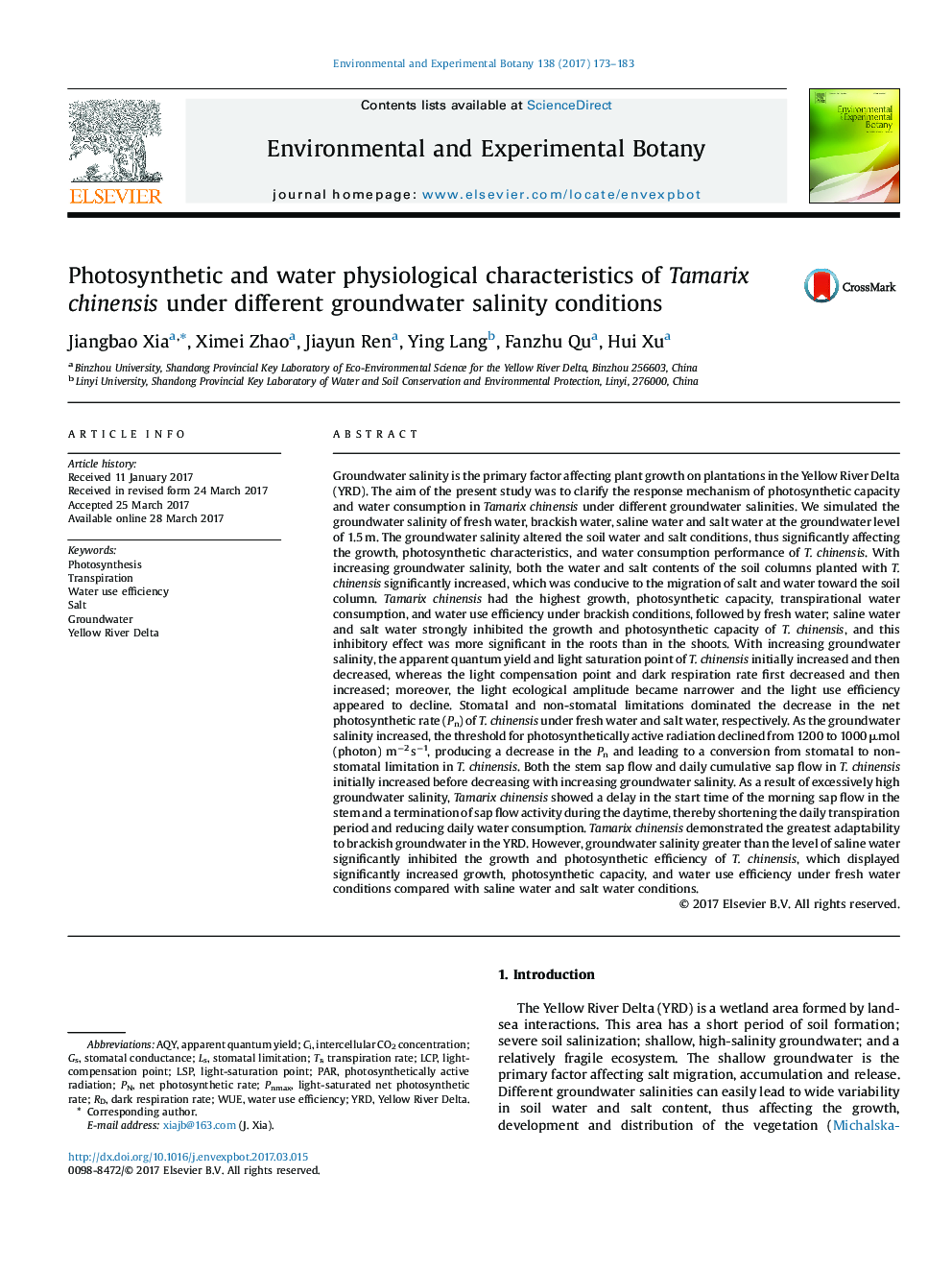| کد مقاله | کد نشریه | سال انتشار | مقاله انگلیسی | نسخه تمام متن |
|---|---|---|---|---|
| 5766674 | 1628039 | 2017 | 11 صفحه PDF | دانلود رایگان |

- Groundwater salinity significantly affected soil water and salt content.
- Photosynthesis by T. chinensis under different groundwater salinity was quantified.
- Saline groundwater severely inhibited the root growth of T. chinensis.
- Tamarix chinensis showed the highest photosynthesis under brackish groundwater.
- The threshold of PAR for non-stomatal limitation in T. chinensis was identified.
Groundwater salinity is the primary factor affecting plant growth on plantations in the Yellow River Delta (YRD). The aim of the present study was to clarify the response mechanism of photosynthetic capacity and water consumption in Tamarix chinensis under different groundwater salinities. We simulated the groundwater salinity of fresh water, brackish water, saline water and salt water at the groundwater level of 1.5 m. The groundwater salinity altered the soil water and salt conditions, thus significantly affecting the growth, photosynthetic characteristics, and water consumption performance of T. chinensis. With increasing groundwater salinity, both the water and salt contents of the soil columns planted with T. chinensis significantly increased, which was conducive to the migration of salt and water toward the soil column. Tamarix chinensis had the highest growth, photosynthetic capacity, transpirational water consumption, and water use efficiency under brackish conditions, followed by fresh water; saline water and salt water strongly inhibited the growth and photosynthetic capacity of T. chinensis, and this inhibitory effect was more significant in the roots than in the shoots. With increasing groundwater salinity, the apparent quantum yield and light saturation point of T. chinensis initially increased and then decreased, whereas the light compensation point and dark respiration rate first decreased and then increased; moreover, the light ecological amplitude became narrower and the light use efficiency appeared to decline. Stomatal and non-stomatal limitations dominated the decrease in the net photosynthetic rate (Pn) of T. chinensis under fresh water and salt water, respectively. As the groundwater salinity increased, the threshold for photosynthetically active radiation declined from 1200 to 1000 μmol (photon) mâ2 sâ1, producing a decrease in the Pn and leading to a conversion from stomatal to non-stomatal limitation in T. chinensis. Both the stem sap flow and daily cumulative sap flow in T. chinensis initially increased before decreasing with increasing groundwater salinity. As a result of excessively high groundwater salinity, Tamarix chinensis showed a delay in the start time of the morning sap flow in the stem and a termination of sap flow activity during the daytime, thereby shortening the daily transpiration period and reducing daily water consumption. Tamarix chinensis demonstrated the greatest adaptability to brackish groundwater in the YRD. However, groundwater salinity greater than the level of saline water significantly inhibited the growth and photosynthetic efficiency of T. chinensis, which displayed significantly increased growth, photosynthetic capacity, and water use efficiency under fresh water conditions compared with saline water and salt water conditions.
Journal: Environmental and Experimental Botany - Volume 138, June 2017, Pages 173-183